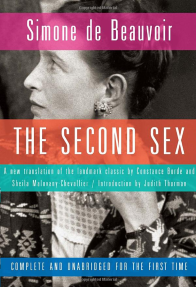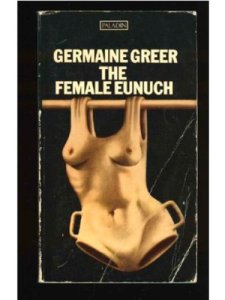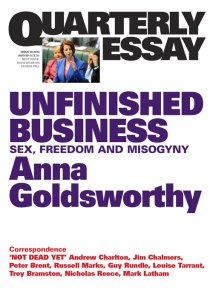 Last night I was lucky enough to be asked by the YWCA of Canberra to speak at a film screening of the documentary I am a girl. Below is a transcript of the speech I made following the film.
Last night I was lucky enough to be asked by the YWCA of Canberra to speak at a film screening of the documentary I am a girl. Below is a transcript of the speech I made following the film.
I am a Girl
In light of the remarkable documentary I am a girl, and as we come up to the International Day of the Girl Child, I thought today it might be interesting to look at some of the ways in which the concept of the girl has been considered in an academic context, and how we might see this film as doing work in contributing to this conversation. So briefly I want to talk about three things:
- First, what has been said about the girl in academia, specifically, feminist writing?
- Second, how might we see even the title of the film I am a girl functioning as a powerful statement and intervention in conversation about the girl?
- Third, why should we care about the girl in academia and feminism?

What has been said about the girl?
At face value, girlhood implies a period of flux, of change. As Simone de Beauvoir famously said, “one is not born, but rather becomes, woman” (283). And in de Beauvoir’s account in The Second Sex, the girl is but one step in this process of becoming. However, for de Beauvoir girlhood is not a stopping point – the girl is always caught up in being compelled toward her future state, woman. As de Beauvoir explains, “She is already detached from her childhood past, the present is for her only a transition; she sees no valid end in it, only occupations. In a more or less disguised way, her youth is consumed by waiting. She is waiting for man” (341).
Germaine Greer takes a similar perspective to de Beauvoir in The Female Eunuch, insofar as she acknowledges the weight of expectations imposed upon girls, but she writes, “I would not be doing justice to girls if I were to imply that they accepted their enculturation without struggle” (78). Greer goes on to state that, “the pre-pubescent girl, however sluggish and confused she may seem to the disenchanted observer, is a passionate creature” (80).
 This conflict between identifying the structural limitations imposed on girls, while at the same time acknowledging the agency of girls themselves, continues to be a persistent tension in feminist writing.
This conflict between identifying the structural limitations imposed on girls, while at the same time acknowledging the agency of girls themselves, continues to be a persistent tension in feminist writing.
Furthermore, often feminist writing has not settled on the girl as a focus for attention – often the girl is only discussed as a marker of transition on the way to what is often given more significance- the question of woman. However in very recent times we have seen the rise of “girlhood studies” which is attempting to give questions of the girl centre stage.
Theorists in this new field of study, such as Jackie Kirk, Claudia Mitchell and Jacqueline Reid-Walsh, have attempted to provide a map for understanding discussions of the girl in a contemporary global context (16). Three dominant themes that have emerged from this research are that:
- Girls are often pathologised as victims of material deprivation and restrictive gender roles, particularly in development contexts (20-22);
- Girls are seen as problematic consumers of “tween culture”, particularly in Western contexts (22-23); and
- Given these restrictions, girls are seen to be already coopted and lacking the agency to have their own opinions or speak for themselves (24).
 We might note that even with the best critical intentions, sometimes discussion of the girl can carry a heavy weight that reduces the girl to a dupe of systemic oppression. Take for example, Anna Goldsworthy’s recent piece for the Quarterly Essay, Unfinished Business: Sex, Freedom and Misogyny. In part, Goldsworthy considers the dangers of girlhood today, framed as young womanhood, particularly the self-objectifying practices girls are taking part in online, as she writes, “the young woman is the celebrity at the centre of her Facebook universe, which might look like self-esteem but is ultimately a form of self-effacement” (37). That is to say, Goldsworthy argues that girls may be in charge of the creation of their self-image, but these are images that are in fact erasing girls. She asks, “is it only by photographing herself that she knows she’s real?” (38).
We might note that even with the best critical intentions, sometimes discussion of the girl can carry a heavy weight that reduces the girl to a dupe of systemic oppression. Take for example, Anna Goldsworthy’s recent piece for the Quarterly Essay, Unfinished Business: Sex, Freedom and Misogyny. In part, Goldsworthy considers the dangers of girlhood today, framed as young womanhood, particularly the self-objectifying practices girls are taking part in online, as she writes, “the young woman is the celebrity at the centre of her Facebook universe, which might look like self-esteem but is ultimately a form of self-effacement” (37). That is to say, Goldsworthy argues that girls may be in charge of the creation of their self-image, but these are images that are in fact erasing girls. She asks, “is it only by photographing herself that she knows she’s real?” (38).
Now, this might be a compelling argument for some people, but I think it is vital that we pay attention to how these accounts are framing girls. Though there may be processes operating whereby girls are disempowered at one level, simultaneously these same girls may be empowered in other ways. Complexity should not be brushed over in favour of more simple explanations when it comes to investigations of the girl. We need to hear from girls about their own experiences- when we do, often extraordinary things are revealed.
How does I am a girl intervene in this discussion?
The title of this documentary alone provides a fascinating entry into this discussion of the girl. The power of the declaration “I am a girl” becomes ever apparent with comparison to the perhaps more prolific statement – “it’s a girl”.
 As gender theorist Judith Butler has pointed out, we are “called into being” by identity statements – the phrase “it’s a girl” at birth enmeshes us in a process of being “girled” (xvi). That is to say, being labeled a girl is involved with a whole set of role expectations and bodily styles of the “feminine”. As Iris Marion Young argues in Throwing like a Girl, assigning the marker “girl” functions as part of creating less powerful bodies; she writes: “The girl learns actively to hamper her movements. She is told that she must be careful not get hurt, not to get dirty, not to tear her clothes, that the things she desires are too dangerous for her” (154).
As gender theorist Judith Butler has pointed out, we are “called into being” by identity statements – the phrase “it’s a girl” at birth enmeshes us in a process of being “girled” (xvi). That is to say, being labeled a girl is involved with a whole set of role expectations and bodily styles of the “feminine”. As Iris Marion Young argues in Throwing like a Girl, assigning the marker “girl” functions as part of creating less powerful bodies; she writes: “The girl learns actively to hamper her movements. She is told that she must be careful not get hurt, not to get dirty, not to tear her clothes, that the things she desires are too dangerous for her” (154).

Of course Young’s work plays on the idea that often the statement “throwing like a girl” is used as an accusation or insult. To call something “girlie” is to emphasise that it is underdeveloped or infantile. With age, the proclamation at birth of “it’s a girl” transforms into the charge that one is “just a girl”.
But the title of this film, I am a girl refigures these notions – girlhood is claimed as a position one can be proud to occupy. To say “I am a girl” is to erase the “just” and proclaim this subject position as something to take ownership of. Importantly, the title is not “Nearly a woman” or “I am a young woman”- it marks girl out as a category that might carry a weight of social implications, but that deserves special attention in itself.
And further, the title implies an idea of the girl speaking for herself, but that this is a subject position the viewer can also relate to. Here the “I” functions as the voice of the girl, but also as a space of empathy- it calls for us to put ourselves in the place of the girl as we hear her story.
So from this perspective, we can see the documentary as making an intervention on the topic of the girl, in that we are encouraged to consider:
- What possibilities are imaginable for these girls; what kinds of women are these girls compelled to become?
- And, how can we acknowledge these difficulties without making girls victims?
- But also, where can we see small points of resistance emerging from the girls themselves, and how can we work together across different cultural contexts to make sure these girls are supported to transform boundaries and limitations imposed upon them?
Why should we care about girls?
 The final point for consideration today is why the girl is important? Why should we care about girls in feminism and academia broadly? As a leading theorist in the field of girlhood studies, Catherine Driscoll, has commented: “As a future-directed politics, as a politics of transformation, girls and the widest range of representations of, discourses on, and sites of becoming a woman are crucial to feminism” (9). Driscoll implores us not to erase girlhood in the question of becoming woman which is central to feminism.
The final point for consideration today is why the girl is important? Why should we care about girls in feminism and academia broadly? As a leading theorist in the field of girlhood studies, Catherine Driscoll, has commented: “As a future-directed politics, as a politics of transformation, girls and the widest range of representations of, discourses on, and sites of becoming a woman are crucial to feminism” (9). Driscoll implores us not to erase girlhood in the question of becoming woman which is central to feminism.
But Driscoll also notes that the question of the girl is not only relevant because it refers to a developmental stage prior to the “independent woman as feminist subject” (9). We need to make sure that while we acknowledge the importance of the girl in relation to the question of woman, the girl does not get lost in this discussion.
 It is vital that we hear from girls themselves – as I am a girl implores us to do. And while identifying limitations that are socially placed upon girls, let girls tell these stories so as not to erase their voice in this process, but also so that a diversity of perspectives might ring out. After all, we cannot expect that the needs of girls should be the same across all contexts, or that all girls will share the same experiences. In acknowledging the category “girl”, particularly across cultural boundaries, we need to make sure that difference is held as key.
It is vital that we hear from girls themselves – as I am a girl implores us to do. And while identifying limitations that are socially placed upon girls, let girls tell these stories so as not to erase their voice in this process, but also so that a diversity of perspectives might ring out. After all, we cannot expect that the needs of girls should be the same across all contexts, or that all girls will share the same experiences. In acknowledging the category “girl”, particularly across cultural boundaries, we need to make sure that difference is held as key.
On the one hand, it is crucial that we see the girl within a future trajectory – what are her possibilities of who she might become? And to this point, a sense of hope is important for imagining different futures. But by the same token, the girl in the now needs to be considered- not just who she will become or who she might be, but what she has to say in this moment. Because it is only in this acknowledgment – that the present is actually the future – that we can hope to come together not to rescue girls but to amplify their voices as they mark out their own space in a changing world.
References
Beauvoir, Simone de. The Second Sex, Trans. Constance Borde and Sheila Malovany-Chevallier. New York: Alfred A. Knopf, 2010 [1949].
Butler, Judith. Bodies that Matter: On the Discursive Limits of “Sex”. London; New York: Routledge, 2011 [1993].
Driscoll, Catherine. Girls: Feminine Adolescence in Popular Culture and Cultural Theory. New York: Columbia University Press, 2002.
Goldsworthy, Anna. ‘Unfinished Business: Sex, Freedom and Misogyny’. Quarterly Essay. Issue 50, Collingwood: Black Inc., 2013.
Greer, Germaine. The Female Eunuch. London: Granada Publishing Limited, 1970.
Kirk, Jackie, Claudia Mitchell and Jacqueline Reid-Walsh. ‘Toward Political Agency for Girls: Mapping the Discourses of Girlhood Globally’. Girlhood: A Global History. Ed. Colleen A. Vasconcellos and Jennifer Helgren. New Brunswick, N.J.: Rutgers University Press, 2010.
Young, Iris Marion. Throwing like a Girl and Other essays in Feminist Philosophy and Social Theory. Bloomington; Indianapolis: Indiana University Press, 1990.

Pingback: LITERARY OR POPULAR FICTION? | How my heart speaks
Pingback: LITERARY OR POPULAR FICTION? | Cool lady blog
Pingback: Germaine Greer sells archive to University of Melbourne